CW83 August, 2023
The one hundredth anniversary of the Great Kanto Earthquake

One hundred years have passed since the Great Kanto Earthquake hit Tokyo and Kanagawa prefecture on September 1, 1923 at 11:58. Only centenarians have first-hand experiences of the devastating earthquake, and lessons from the tragic disaster have become lost in the mists of time. Most of us have to learn from historical records how serious the damage the earthquake inflicted was on the metropolitan area. The earthquake registered seven on the Japanese scale in the Shonan area, the same seismic intensity as that in the Great East Japan Earthquake in March 2011.
About 105,000 people died or went missing and 92,000 of them died due to conflagrations. The death toll in Chigasaki town, whose population was around 20,000 in those days, reached about 90, and 80% of houses were destroyed. The closer to the Sagami River, the higher the percentage of destroyed houses was. But none of the houses were burned*. This was because residents were mostly farmers and they started working early in the morning. They had lunch before noon and were taking a break when the earthquake occurred. It was lucky that most cooking stoves in the town were unlit. A tsunami did not come, either, though a four-meter tsunami hit Kamakura within ten minutes. In and around the estuary of the Sagami River, the seabed and the ground rose and river water inundated the vast area of Yanagishima.
*Masayuki Takemura, 2013, Report on the Field Survey for the Memorial Matters from the 1923 Great Kanto Earthquake at Chigasaki and Samukawa Cities in Central Kanagawa Prefecture, Japan, 歴史地震, 28, 1-17
Another Crane has landed on Chigasaki
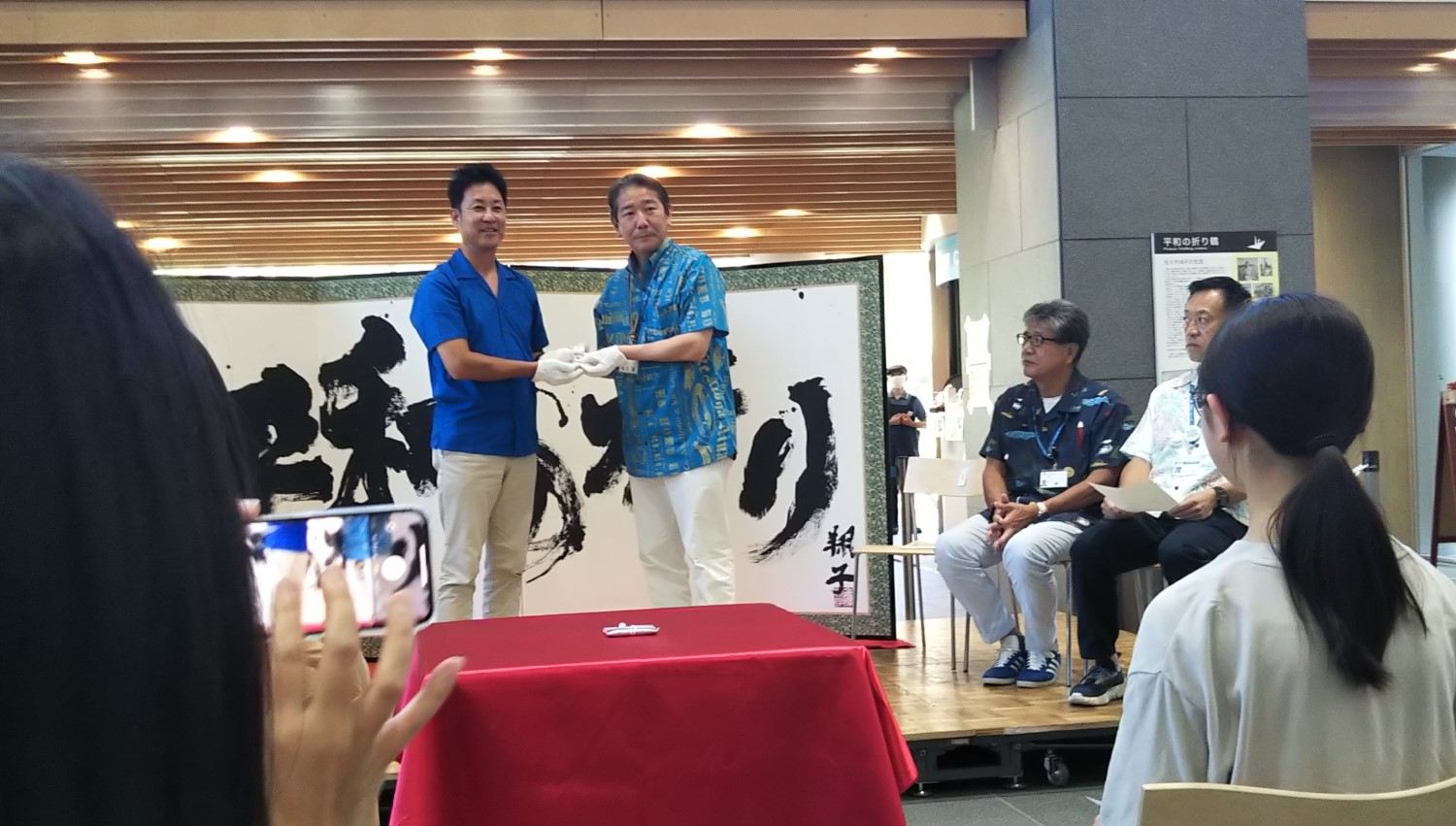
A metal crane, a replica of Sadako’s paper crane, was presented to Chigasaki Mayor Hikaru Sato by Sadako’s nephew Yuji Sasaki, the vice chairman of The Sadako Legacy NPO at City Hall on August 3 (Thu). The crane was the same as those presented to G7 leaders at the G7 Hiroshima Summit in May.
The NPO had already given one of her paper cranes to the city back in August 2017. See CW16, Sept. 1, 2017.
A Sadako paper crane was presented to Honolulu in September 2013, a year before Honolulu and Chigasaki concluded the sister city relationship. Finding the crane in Honolulu, people in Chigasaki asked the NPO for a crane. In the summer of 2016, Sasaki, a singer- song writer, was invited to the peace gathering in Chigasaki, and was asked by a citizen group to think about providing the city with Sadako’s paper crane.
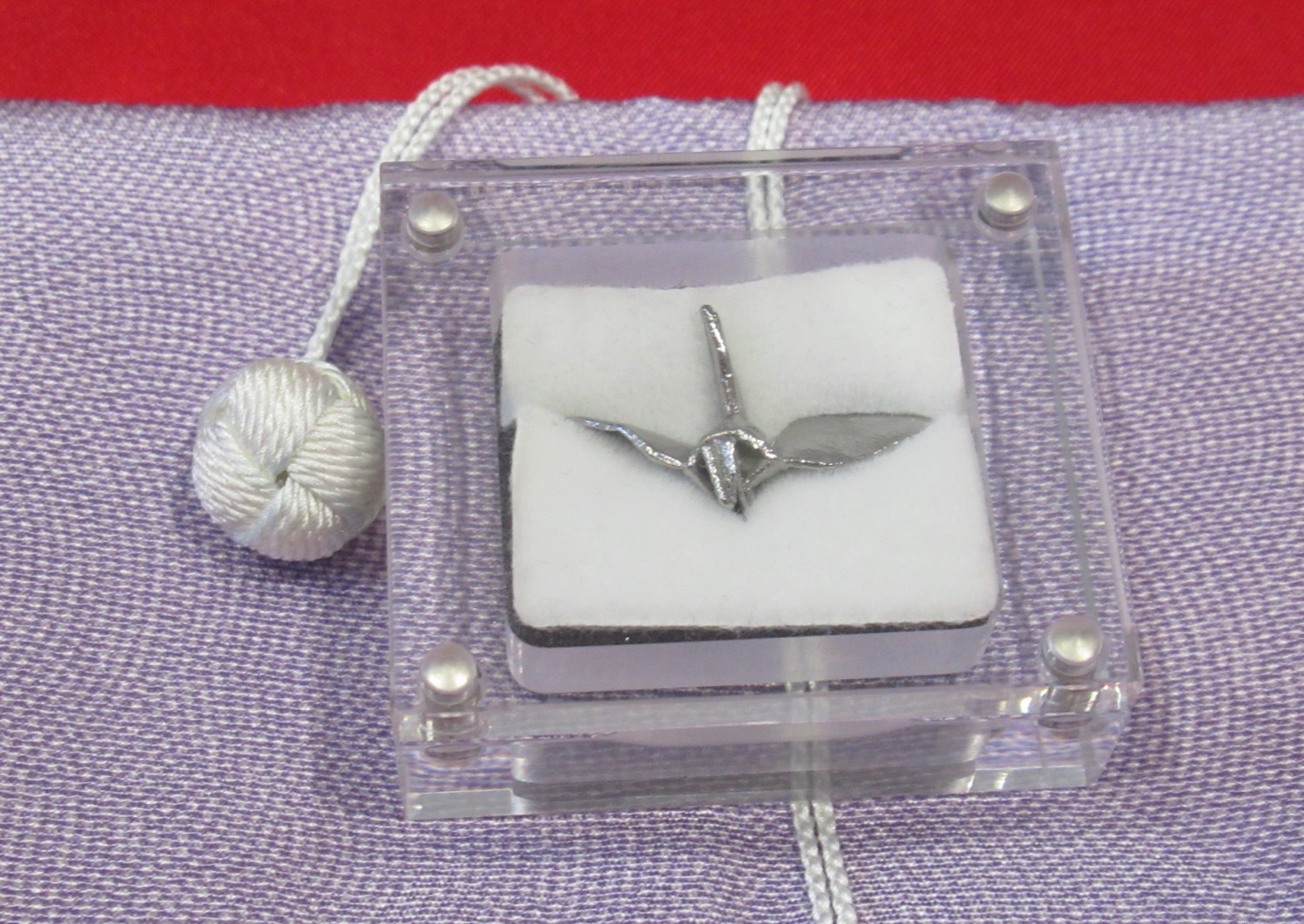
Sadako Sasaki was exposed to radiation at her house about 1.6 km from the ground zero when she was two years old. She developed leukemia at 10 and died at 12. Sadako folded paper cranes while she was confined to bed in the hospital. As a symbol of peace, her paper cranes have been presented to many cities at home and abroad. As paper cranes deteriorate with the lapse of time, the NPO and a foundry company in Hiroshima prefecture made metal cranes by precision casting.
Flowers of the season: Japanese silver grass
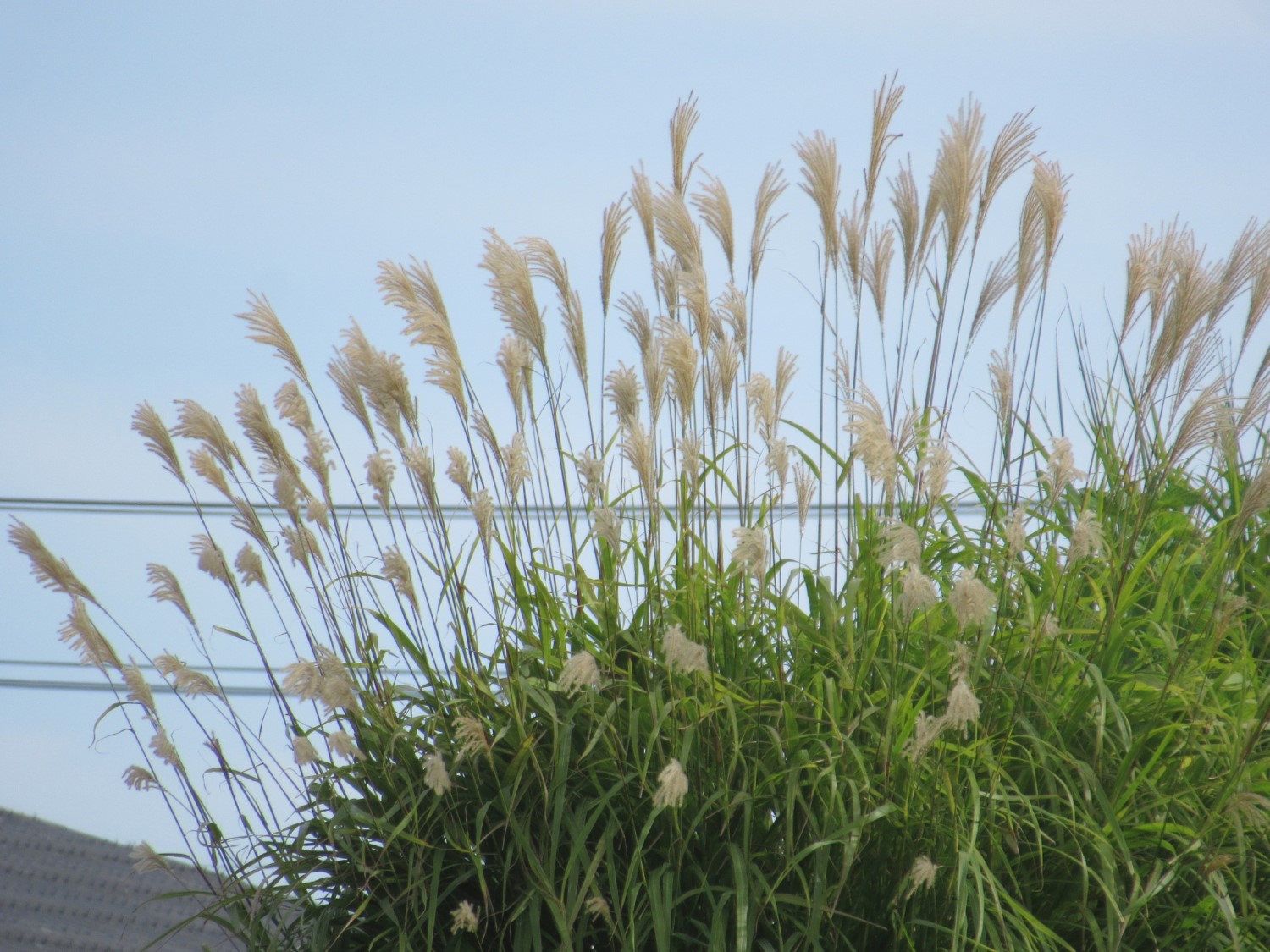
Japanese silver grass is indispensable to the traditional moon viewing custom on the full moon night of August 15 in the lunar calendar. People look at a full moon, feeling grateful about bumper harvests. Japanese silver grass, called ‘Susuki’ or ‘Kaya’ in Japanese, was used as thatching material and livestock feed so that there used to be silver grass plains, called ‘Kayaba’, near settlements. People reaped them regularly and used them for various purposes in their daily lives. However, after they stopped using the grass, and left the plains untreated, pioneering trees, such as Japanese red pines, started to appear in the grassy plains, and the grasslands were gradually transformed into wooded grassland.
Bushy Poaceae plants, including Japanese silver grass, take time to grow thickly and to cover plains. Japanese silver grass plains spread in Sengokuhara, Hakone. People throng there to enjoy walking in autumn. We should learn that the plains have been preserved by human hands.
Japanese silver grass inhabits sunny plains in Japan, China and Taiwan as well as on the Korean peninsula. They have short but solid rhizomes and many leaves, one to two meters long, and shoot up from the roots. Leaves are abundant in silicic acid so that solid leaves with keen hook edges slash our skins easily. From late summer to autumn, its stalk bears more than ten spicate flowers 20-30 cm long. At first, they are reddish and then caryopses (seeds) are covered with white hairs so that they are conveyed by the wind. In winter, their aerial parts wither, but in Okinawa, its leaves are green throughout the year, and the grass grows up to five meters high. Now in the North America, the plants are rampant as an invasive foreign species, just like a reverse case of Toll goldenrod in Japan.
By the way, the next full moon this year is September 29 (Fri).
History of Chigasaki: Kowada Village (1)

Kowada Village of the Edo period was located in the south-east of today’s Chigasaki city and was made up of the following districts: Kowada, Akamatsu, Motojuku, Daikan, Kozakura, Deguchi, Hibarigaoka, Hamatake, Matsunami, Misumi, Asahigaoka, Tokiwa, Fujimi, Heiwa, Matsugaoka, Shiomidai, Midorigahama, Hamasuka, Hishinuma-kaigan, and Shorin-1-chome.
The reason it was unable to draw the definite border between Kowada and Hishinuma Villages was the fact that there was a lot of common land near the border. In 新編相模国風土記稿 (the new edition of Sagami province topography) says the border was quite complex like the fangs of a dog. It is still unclear what reason was behind the obscure border. Generally speaking, the neighboring area of Ooyama Highway was Hishinuma Village, and from either side of Tokaido (Route one) to the beach was Kowada Village. The map above roughly shows the area of Kowada Village.
Kumano Shrine, the village shrine of Kowada, enshrines unique deities. The small shrine in the right of the worship hall enshrines Ubagami with long hair which is carved on a stone. The small shrine is recorded in the 1798 detail note of the village as 姥神宮 (Ubajingu). The shrine had been at Naga-machi in today’s Hishinuma-3-chome until it was brought to the present place in the Meiji era (1868-1912).
It is said that parents prayed to the deity for their children with tea when they got a cold. If the deity was a goddess, it can be considered to be similar to those enshrined in Serizawa and Imajuku, “Gya-gi or Gya-gya old woman”.
Short Essays on Chigasaki – 4 Minamoto-no-Yoritomo & Inage Shigenari and a Memorial Bridge Service over the Sagami River(in the Middle Ages) (Bimonthly serial)
Inage Shigenari was an immediate vassal of the shogun, Minamoto-no-Yoritomo, in the 12th century. When Shigenari lost his wife, a younger sister of Yoritomo’s wife, Masako, in 1198, he built a memorial bridge over the Sagami River. Yoritomo participated in the bridge opening ceremony, and on his way back to Kamakura, he fell from his horse. Later, he passed away on January 13, 1199.
‘Azuma Kagami (吾妻鏡)’, the Japanese medieval text that chronicles events of the Kamakura Shogunate (1185-1333), lacked records about the bridge memorial service, but ‘Houryaku-kanki (保曆間記)’, a history book written by aristocracies in the Nanboku-cho era (1336-1392), described Yoritomo was much annoyed by the ghost of his younger brother, Yoshitsune, who appeared at Yatsumatogahara (八的ヶ原)*1, and that of Emperor Antoku*2 who appeared on the sea off Inamuragasaki, the promontory in Kamakura.
Why did the excellent horseman fall from his horse? Did he get drunk after the memorial service? From a medical point of view, he did not die on the spot, but died from cerebral hemorrhage caused by falling from his horse. Did he pass away in his unconscious condition without signs of recovery?
(The source of the essay: Chigasaki People’s Book published by Chigasaki City)
*1 Yatsumatogahara literally means eight target field. The place was used as a bow shooting range with eight targets in the Kamakura era. It was located in present-day Tsujido, Fujisawa city.
*2 Emperor Antoku was the 81st emperor of Japan, who ascended the throne at the age of two, reigning from 1180 to 1185 the shortest span in history. During the climactic sea battle at Dan-no-ura, in today’s Yamaguchi prefecture, between the Genji led by Yoshitsune, Yoritomo’s younger brother, and the Taira in April 1185, Antoku's grandmother, Taira no Tokiko, plunged into the water in the Shimonoseki Straits with him. She thought it was a better decision to drown herself with the child emperor than to allow him to be captured by the opposing forces, the Genji.

In the 2022 NHK drama, the 13 Lords of Shogun, Inage Shigenari (played by Masaki Murakami) was involved in a plot and died a violent death.
However, one of his achievements is preserved as a national ruin and natural monument. In the Great Kanto Earthquake in 1923, bridge piers suddenly appeared in the rice paddy in Machiya by liquefaction. Historian Yorisuke Numata found these piers were remnants of the bridge over the Sagami River constructed by Inage Shigenari in 1198.
Today, the site is a cherry-blossom viewing spot and provides a rest place for people throughout the year.
Weekly cases in Kanagawa hit a new high
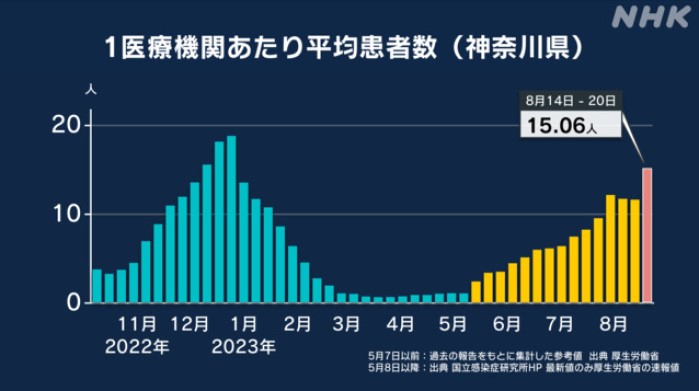
The average number of patients per hospital in the week of Aug. 14 was 15.06, hitting a new high after statistics were changed to the current style in May. During the week, 5,059 cases were reported from 336 medical facilities. The figure per hospital jumped by 3.51 from the previous week.
A professor at the Toho Uni. said infections spread in the summer of the past three years because new variants appeared in each summer. However, the current virus, Omicron XBB, is not a new but a subspecies of Omicron. Nevertheless, it has been almost a half year since the eighth wave has subsided, and it is feared that our immunity has dropped. We should be careful about the next wave.
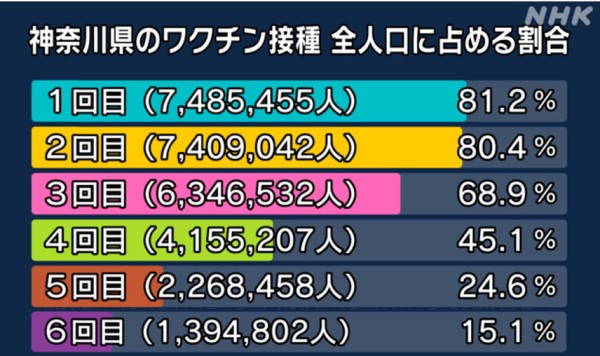
As for vaccination percentages, only 15.1% of residents have received the fourth booster, 0.7% up from the previous month. As many clinics closed during the Obon season, medical facilities receiving patients were filled with people worrying about being infected with the virus, and the percentage of those diagnosed as coronavirus positive has been increasing.
School teachers put on a play at the Civic Hall

A theatrical circle of primary school teachers in Chigasaki and Samukawa played a drama about a special support class at the Civic Hall for the first time in four years. The circle called 茅小演, or Chishoen, the abbreviation for 茅ヶ崎 小学校教諭 演劇サークル, played “one year of the special support class” humorously. They picked up on annual events, including a sports day, an overnight trip, and an excursion. In the class, there are children who need support to talk or to go to the toilet. Former teacher Yasuhide Baba, who had taught normal classes for 30 years, wrote the script and directed members’ performances based on his experiences. He became the homeroom teacher of a special support class for the first time after he retired, and his affectionate eye toward children filled the drama with a warm atmosphere.
The circle played the drama four times, twice on each of August 19 (Sat) and 20 (Sun). In 1988, a study society of primary school teachers in Chigasaki and Samukawa adopted amusing sketches to liven up classes. This was the beginning of the theatrical circle. Since then, they have played dramas about schools and local society every two years. Currently the circle has nine teachers who are in their 60s, 70s and 80s, and all have been members since 1988.
Interested in Japanese proverbs?
1)親の欲目 (OYA NO YOKUME)
OYA means parents, NO their, and YOKUME to favor their children.
As children are so cute to their parents, most of them tend to overestimate children’s ability, looks and many other characteristics. However, as they grow, parents find and accept harsh realities.
Nevertheless, children are irreplaceable treasures of parents, who notice themselves of the distant past in children, because children resemble their parents. This is Mendel’s law of heredity. It is only natural that parents’ love for their children sometimes blind them to their faults.
The saying is in 仮名手本忠臣蔵, or Kanadehon Chushingura, which is a typical kabuki program dealing with the Ako incident, a revenge for the punished lord of Ako domain. It was first performed in Osaka in 1748.
Its English equivalents are:
●The crow thinks her own bird fairest.
●All his geese are swans.
●The owl thinks her own young fairest.
2)似た者夫婦 (NITA MONO FUFU)
NITA means to resemble, MONO a man and woman, and FUFU a married couple.
Husbands and wives are resembling each other more and more as the years go by. They come to think in the same way, and to like the same songs. They read the same articles in the newspaper. It is also said a man and woman who have a lot in common, for example, the same hobby, or fans of the same actor, will marry.
In fact, not a few couples like the same flavors, wear matching sweaters, and go out together. They watch the same TV programs and use similar wording. Such couples must have established good marital relations.
The saying is in 浮世風呂, or Ukiyoburo, humorous books describing ordinary people’s everyday lives through their talks at a public bath. The series was published from 1809 to 1813.
Its English equivalents are:
●Like husband, like wife.
●As like as two peas in a pod.
●Every Jack has his Jill.
Events in August
Southern Beach Chigasaki Fireworks Display
The 49th Southern Beach Chigasaki Fireworks Display was held from 19:30 to 20:10 on August 5 (Sat). Route 134 near the Southern Beach was crowded with pedestrians and cyclists. This was partly because bicycles were banned from crossing R134 to the beach near the event site this year.
Around 19:30 the first firework was launched with a deafening sound. Skyrockets and underwater-launch fireworks brightened the beach, and spectators, police officers and food carts appeared in the dark. The event, 2,000 fireworks in 40 min, were not as spectacular as those in famous cities. Nevertheless, fireworks overhead had far more power than those we watch on TV. No matter how much you turn up the volume of the TV, your bodies will not vibrate.
Children and their parents and grandparents, young couples, school mates-all enjoyed the midsummer evening event in the sea breeze.
Photo exhibition by Hirofumi Naekawa
Ethologist Hirofumi Naekawa, who has lived in Akabane for 30 years, has kept taking photos of wildlife, including plants, insects and birds, which he encounters while taking a daily walk. In this exhibition, held on August 4 (Fri) to 6 (Sun) at the Citizen Gallery, 90 pictures taken in Akabane and 80 pictures on the Hiratsuka campus of Kanagawa Uni. were on display with short explanations about the pictures.
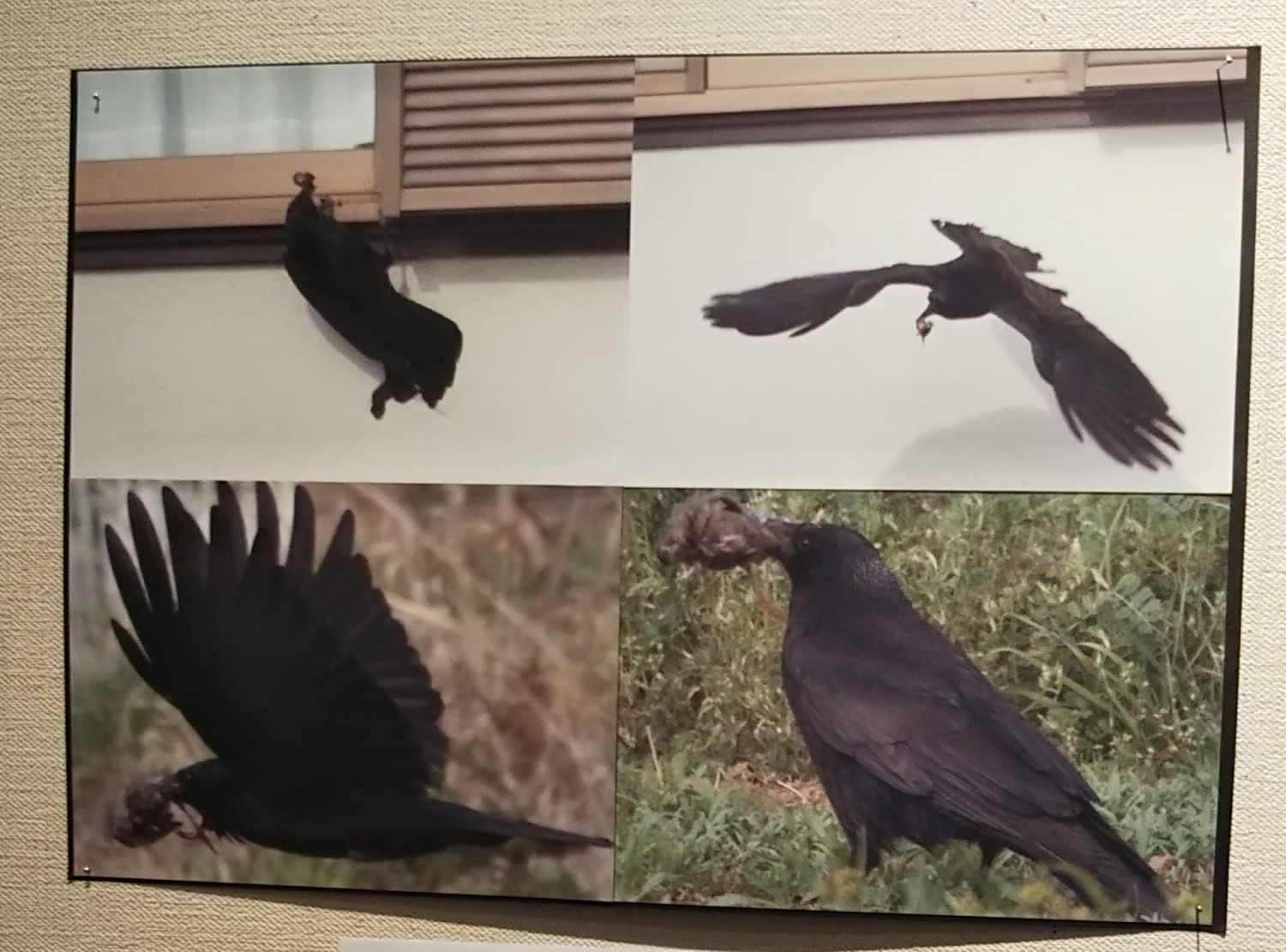
They included rare plants and scenes of the food chains. Some photos captured the critical moments. For example, a crow seized a baby starling which had hatched in a shutter case of a private house (the photo above), and a wasp caught a cicada and made a meat ball from its breast muscle. QR codes were attached to some pictures so that videos can be watched on the Internet. Furthermore, the snake, Dinodon orientale, was caught on camera. Naekawa said the snake is nocturnal, so it is very rare for the snake to appear in daytime. He also said lots of serendipitous associations have made him keep taking pictures.
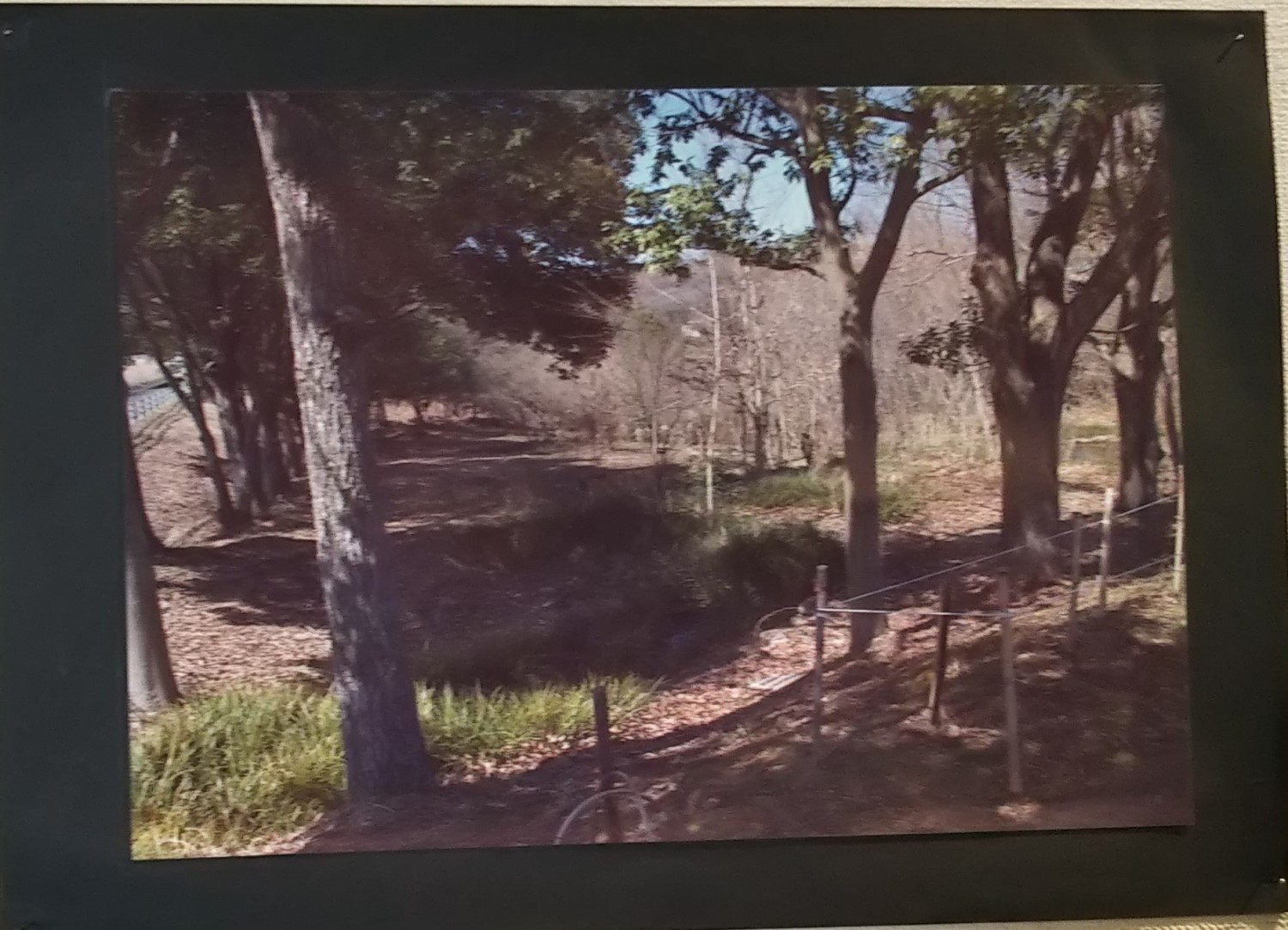
Meanwhile, he deliberately recorded various kinds of plants and insects on the 30-ha campus with woods, grass fields and marshes (the photo above).
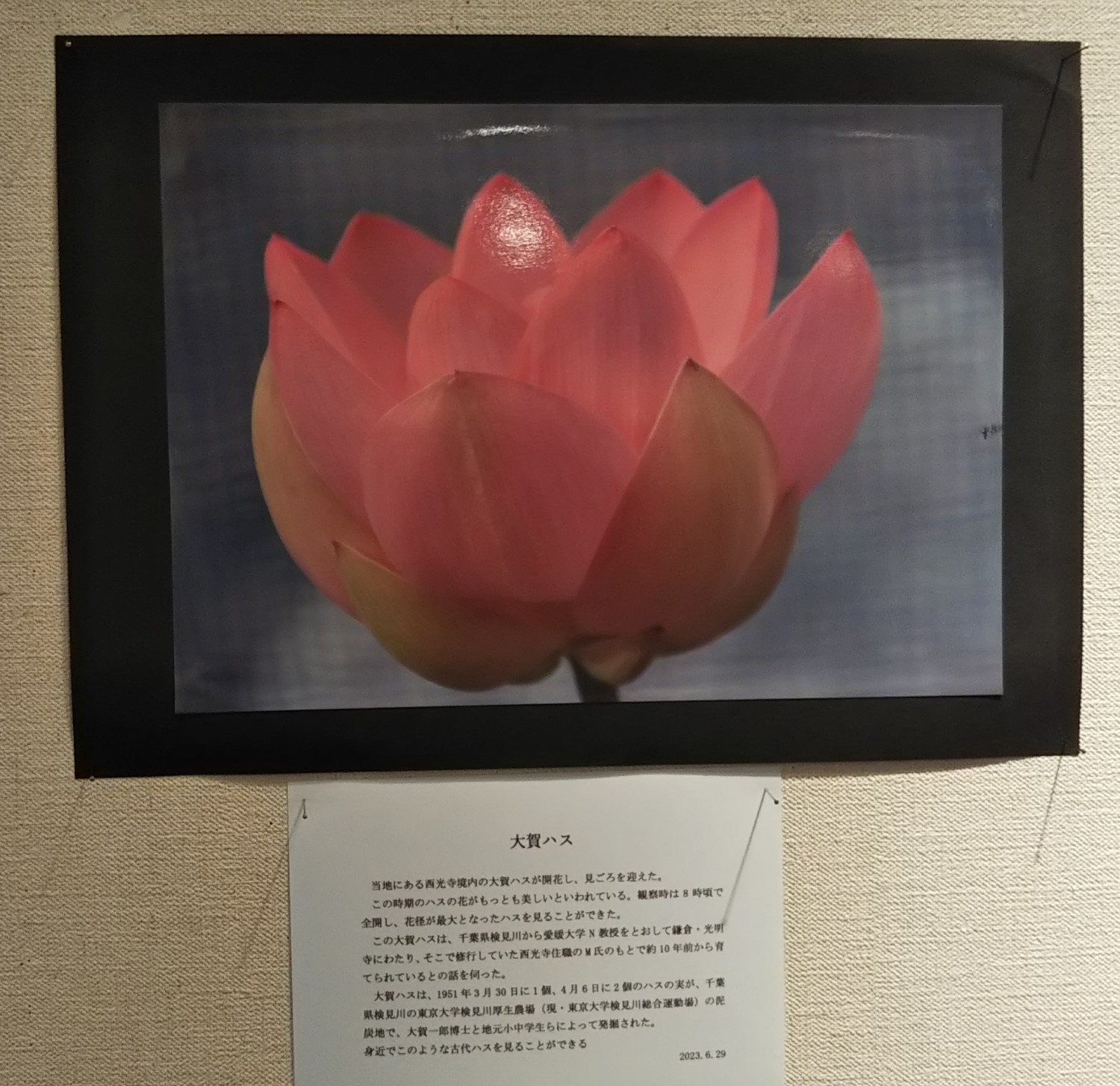
As for photos in the Akabane area, the flower of ancient lotus*1 and red fruits of cobra lily Urashima are out of the ordinary. In addition, there was a photo of a banana tree bearing fruits. We saw its flower at the previous exhibition held in August 2021.
For more details, go to: http://Naekawajcom-home-ne-jp.jimdofree.com
*1: ancient lotus is called “Oga-Hasu” (the photo on the left) named after herbalist Ichiro Oga, who found three lotus seeds at an excavation site of geological layer of Ochiai remains in Chiba, which is assumed to have been a boat berthing place 2,000 years ago. Of the three seeds, only one seed bore pink-colored big flowers with double petals the next year (1952).
Now, the beautiful flowers can be seen not only in Chiba but also in Saitama, Ibaraki and other prefectures. In Chigasaki, a temple master in Akabane brought the lotuses from Chiba and has cultivated them in the vases placed at the entrance and graveyard of the temple.
The first Chigasaki Student Calligraphy Exhibition “Yell”

The first calligraphy exhibition by five calligraphy schools in the city was held at the Citizen Gallery from August 25 (Fri) to the 27th (Sun). About 90 works by elementary to high school students were on display. The theme was “Words to yourself in ten years”. Students wrote their ambitions and appreciation for their parents and friends.

This was the first attempt for these school masters. They seemed to have a lot of unexpected trouble, but their desire to provide their students with an opportunity to show their works overcame difficulties. They hope that their students will learn gratitude through calligraphy, and grow to warm-hearted adults. They also hope that they will be able to hold the exhibition next year and beyond.
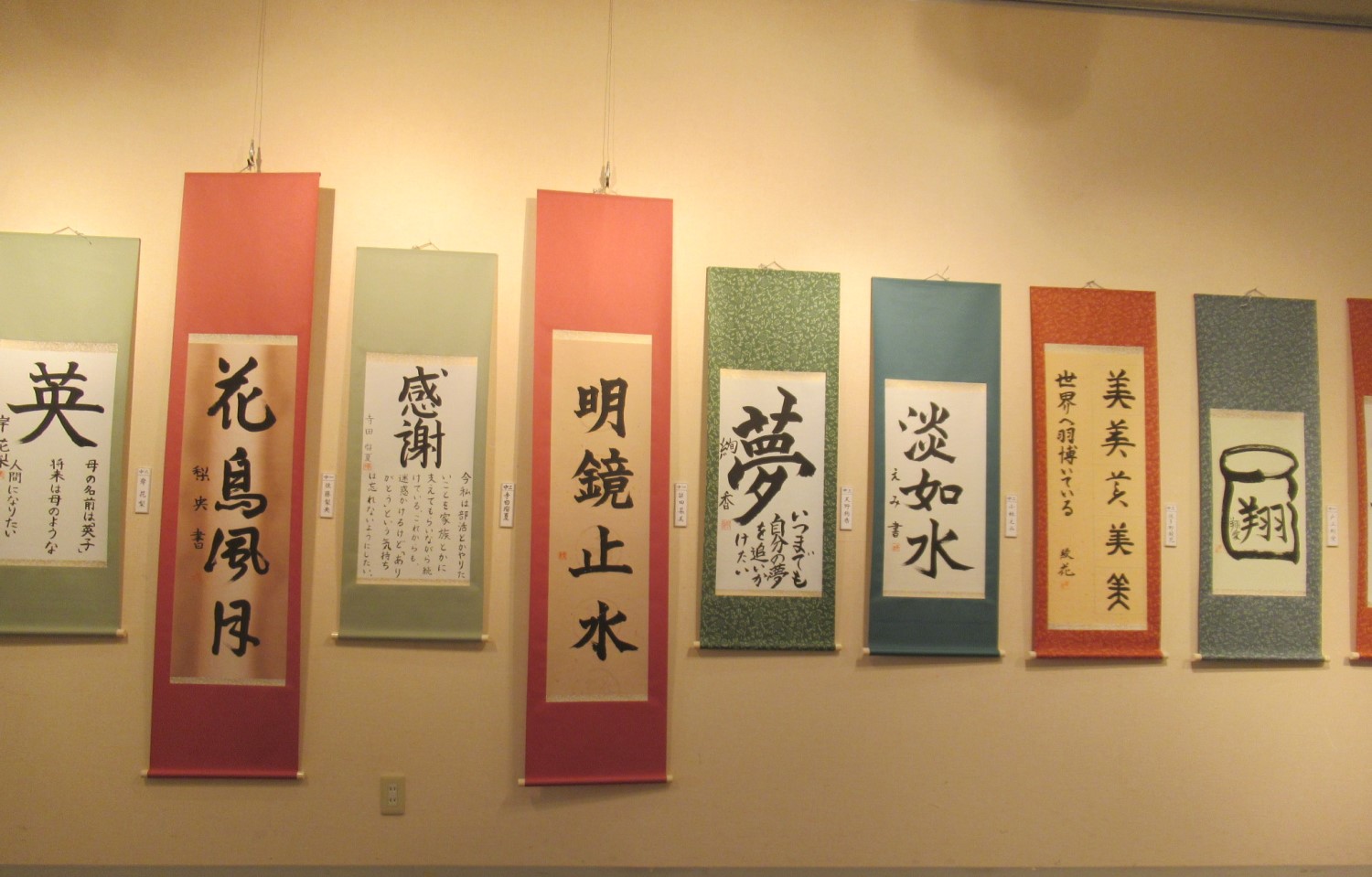
Events in September
Citizen Gallery
●The 8th Miyoshi Association Chigasaki Exhibition by Miyoshi Chigasaki: Sept. 6th (Wed) 13:00 ~17:00, the 7th (Thu) to the 9th (Sat) 10:00 ~ 17:00, the 10th (Sun) 10:00 ~ 16:00
●The 11th photo exhibition by Shonan Photo Club: Sept. 15th (Fri) and the 16th (Sat) 10:00 ~ 18:00, the 17th (Sun) 10:00 ~ 17:00
●The photo exhibition of the Chigasaki Chamber of Commerce and Industry photo class: Sept. 27th (Wed) to the 30th (Sat) 10:00 ~ 18:00, Oct. 1st (Sun) 10:00 ~ 16:00
Yasujiro Ozu exhibition at Chigasaki City Museum of Art

Film director Yasujiro Ozu’s personal belongings, photos and film posters at home and abroad, and many others will be on display. It is well known that he was staying at the inn, Chigasaki-kan, while he was on location in Chigasaki.
One hundred and twenty years have passed since he was born, and 60 years have passed since he departed this life. The exhibition, "OZU ART", is to commemorate the two anniversaries. Date: September 3 (Sun) to November 9 (Thu)
Southern All Stars Chigasaki Live 2023
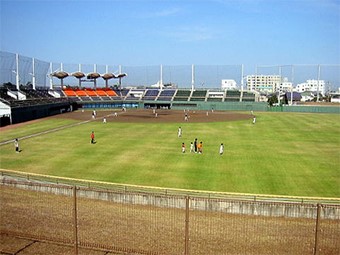
Date: September 27 (Wed) - October 1 (Sun) at Chigasaki Ball Park (See the photo on the left.)
JRE will run special express Eboshi and local trains between Chigasaki and Tokyo from September 27 (Wed) to October 1 (Sun).
For more information, go to https://special-sas45.southernallstars.jp/chigasakilive/ (Southern official site)
https://www.jreast.co.jp/press/2023/yokohama/20230824_y01.pdf> (JRE)